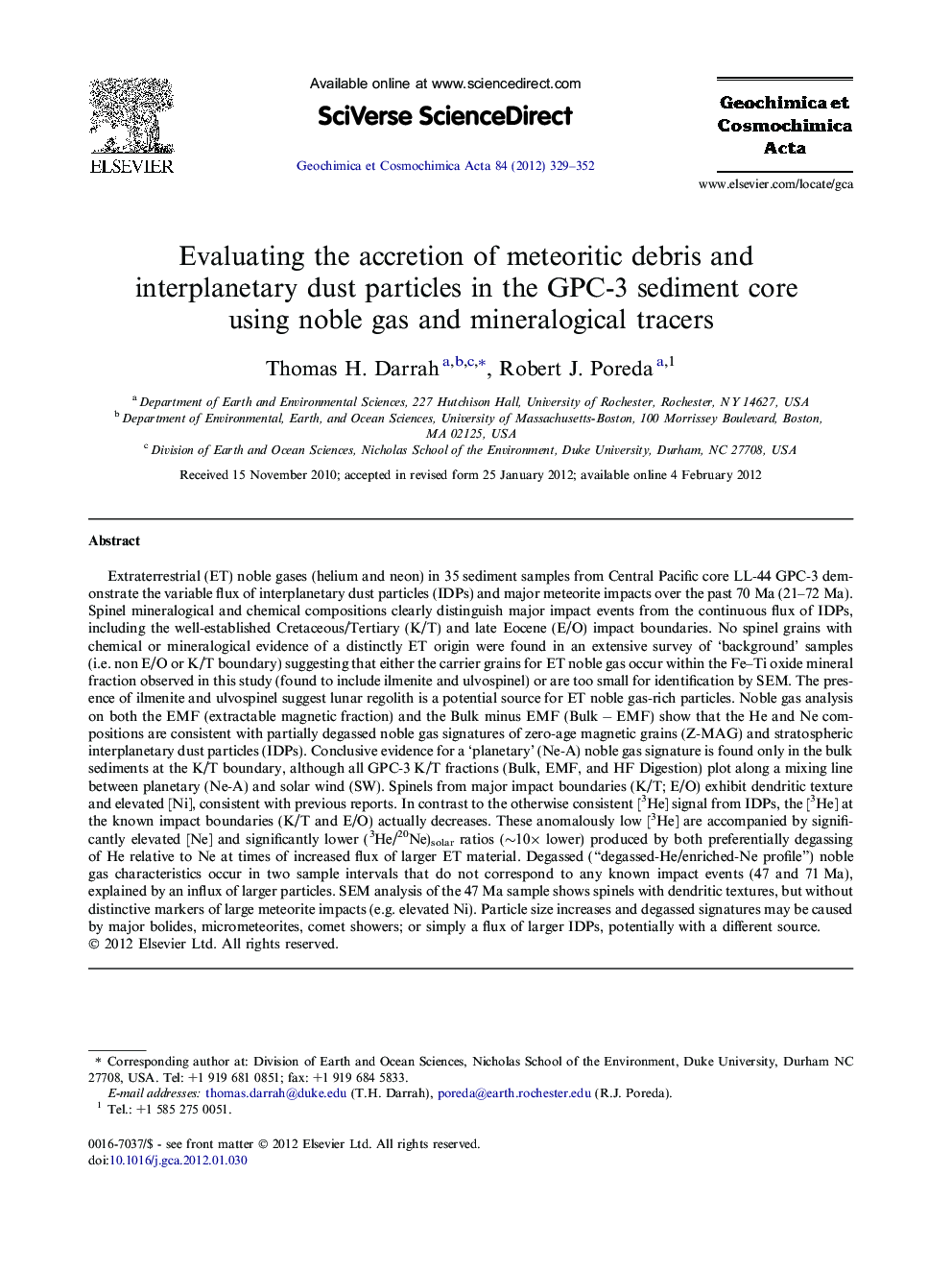| کد مقاله | کد نشریه | سال انتشار | مقاله انگلیسی | نسخه تمام متن |
|---|---|---|---|---|
| 4702952 | 1638073 | 2012 | 24 صفحه PDF | دانلود رایگان |
عنوان انگلیسی مقاله ISI
Evaluating the accretion of meteoritic debris and interplanetary dust particles in the GPC-3 sediment core using noble gas and mineralogical tracers
دانلود مقاله + سفارش ترجمه
دانلود مقاله ISI انگلیسی
رایگان برای ایرانیان
موضوعات مرتبط
مهندسی و علوم پایه
علوم زمین و سیارات
ژئوشیمی و پترولوژی
پیش نمایش صفحه اول مقاله

چکیده انگلیسی
Extraterrestrial (ET) noble gases (helium and neon) in 35 sediment samples from Central Pacific core LL-44 GPC-3 demonstrate the variable flux of interplanetary dust particles (IDPs) and major meteorite impacts over the past 70 Ma (21-72 Ma). Spinel mineralogical and chemical compositions clearly distinguish major impact events from the continuous flux of IDPs, including the well-established Cretaceous/Tertiary (K/T) and late Eocene (E/O) impact boundaries. No spinel grains with chemical or mineralogical evidence of a distinctly ET origin were found in an extensive survey of 'background' samples (i.e. non E/O or K/T boundary) suggesting that either the carrier grains for ET noble gas occur within the Fe-Ti oxide mineral fraction observed in this study (found to include ilmenite and ulvospinel) or are too small for identification by SEM. The presence of ilmenite and ulvospinel suggest lunar regolith is a potential source for ET noble gas-rich particles. Noble gas analysis on both the EMF (extractable magnetic fraction) and the Bulk minus EMF (Bulk â EMF) show that the He and Ne compositions are consistent with partially degassed noble gas signatures of zero-age magnetic grains (Z-MAG) and stratospheric interplanetary dust particles (IDPs). Conclusive evidence for a 'planetary' (Ne-A) noble gas signature is found only in the bulk sediments at the K/T boundary, although all GPC-3 K/T fractions (Bulk, EMF, and HF Digestion) plot along a mixing line between planetary (Ne-A) and solar wind (SW). Spinels from major impact boundaries (K/T; E/O) exhibit dendritic texture and elevated [Ni], consistent with previous reports. In contrast to the otherwise consistent [3He] signal from IDPs, the [3He] at the known impact boundaries (K/T and E/O) actually decreases. These anomalously low [3He] are accompanied by significantly elevated [Ne] and significantly lower (3He/20Ne)solar ratios (â¼10à lower) produced by both preferentially degassing of He relative to Ne at times of increased flux of larger ET material. Degassed (“degassed-He/enriched-Ne profile”) noble gas characteristics occur in two sample intervals that do not correspond to any known impact events (47 and 71 Ma), explained by an influx of larger particles. SEM analysis of the 47 Ma sample shows spinels with dendritic textures, but without distinctive markers of large meteorite impacts (e.g. elevated Ni). Particle size increases and degassed signatures may be caused by major bolides, micrometeorites, comet showers; or simply a flux of larger IDPs, potentially with a different source.
ناشر
Database: Elsevier - ScienceDirect (ساینس دایرکت)
Journal: Geochimica et Cosmochimica Acta - Volume 84, 1 May 2012, Pages 329-352
Journal: Geochimica et Cosmochimica Acta - Volume 84, 1 May 2012, Pages 329-352
نویسندگان
Thomas H. Darrah, Robert J. Poreda,